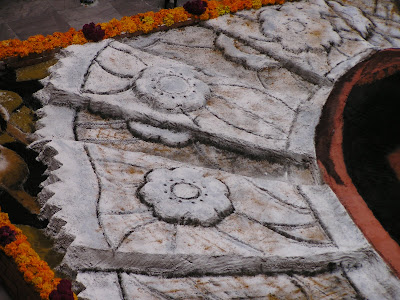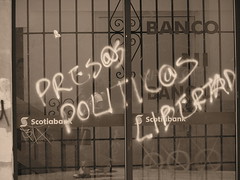Thousands Turn Out to See Frida Kahlo's Moustache
Okay. I know it's not kind to joke, but really, the National Museum in Oaxaca was mobbed on Thursday night when we went in to see the largest tapeta de arena of all. Seriously. We haven't seen so many foreigners in Oaxaca this year until now. Jenna doesn't recall this many when she visited three years ago. I am excited to report that, at least this weekend, tourism thrives in Oaxaca.*
Same for Friday night when we walked down Abasolo all the way to the panteon, the cemetery. Street vendors lined the calle as we got closer, and carnival games were set up in booths. There were little shooting galleries, throw-the-dart-at-the-balloons games and even a small carousel running round and round on a gas powered generator (and much faster than anything you'd see in the States; that's kind of how it goes here: kids are expected to hold on tight and grow up fast) peppered in between stands selling tlayudas, tortas, memelitas, tacos dorado, tostadas, and many, many more food stuffs. Vendors sold cds, jewelry, baskets, leather works, clothing and even kitchen supplies. Oaxacans and tourists made their way through the crowds, each casually inspecting the other amid the noise and celebration.
Only the main gate was open for passage in and out of the panteon, and so the mob merged into a tight stream of people jostling to get in, or out, of the cemetery. A brass band played rompous parade music under the grand concrete awning just inside entry hall, a sort of oom-pah-pah oom-pah-pah with a Latin twist, and candles glowed warmly at every tomb on the walls (picture an Egyptian type catacomb, or something out of the Matrix, slender, horizontal pods extending deep into the walls one on top of the other where bodies were laid to rest and cemented in place).
The graveyard itself, taking up the garden within the massive enclosure, was crowded full with off-kilter above-ground graves in various states of splendor and disarray. In the night, with the air of joyous remembrance and just a tinge of sadness for those most recent, most unjust deaths, with so many candles lighting the paths and the strong aroma of fresh flowers on every breath, with the beer and the mescal and the wine that people brought and shared and poured in plastic cups or real glasses, it was difficult to see the cemetery as a place for somberness, melancholy or sobriety. Families sat on the recently-tended graves of their deceased and told stories, told jokes, sang songs and took turns crying and laughing out loud in honor of the holiday of the dead. I found myself wishing we had a similar custom back home.
I returned to the museum on Friday during the lunch hour to take these photos of Frida when the exhibit was a little less crowded. Ironically enough, a young man stopped me to ask where I was visiting from and the like. I answered his questions in the entryway as he filled in the column on his clipboard, and then I proceeded into the museum. It was only after I took my pictures and headed for the exit that I saw the signs posted in the entrance requesting patrons leave their bags at the bag check and please don't take any photos. Well, nobody stopped me, and in this country that's as good as having gotten permission.
So here are some potentially contraband pics of Mexico's national artista, rendered in sand. These were taken from a second floor mezzanine, looking down on the ground floor. The attention to detail in the portrait of sand is stunning.
*I don't know but suspect that, if asked, local hoteliers would reply that reservations and room rentals are still below average (since the unrest of last summer and fall).
Same for Friday night when we walked down Abasolo all the way to the panteon, the cemetery. Street vendors lined the calle as we got closer, and carnival games were set up in booths. There were little shooting galleries, throw-the-dart-at-the-balloons games and even a small carousel running round and round on a gas powered generator (and much faster than anything you'd see in the States; that's kind of how it goes here: kids are expected to hold on tight and grow up fast) peppered in between stands selling tlayudas, tortas, memelitas, tacos dorado, tostadas, and many, many more food stuffs. Vendors sold cds, jewelry, baskets, leather works, clothing and even kitchen supplies. Oaxacans and tourists made their way through the crowds, each casually inspecting the other amid the noise and celebration.
Only the main gate was open for passage in and out of the panteon, and so the mob merged into a tight stream of people jostling to get in, or out, of the cemetery. A brass band played rompous parade music under the grand concrete awning just inside entry hall, a sort of oom-pah-pah oom-pah-pah with a Latin twist, and candles glowed warmly at every tomb on the walls (picture an Egyptian type catacomb, or something out of the Matrix, slender, horizontal pods extending deep into the walls one on top of the other where bodies were laid to rest and cemented in place).
The graveyard itself, taking up the garden within the massive enclosure, was crowded full with off-kilter above-ground graves in various states of splendor and disarray. In the night, with the air of joyous remembrance and just a tinge of sadness for those most recent, most unjust deaths, with so many candles lighting the paths and the strong aroma of fresh flowers on every breath, with the beer and the mescal and the wine that people brought and shared and poured in plastic cups or real glasses, it was difficult to see the cemetery as a place for somberness, melancholy or sobriety. Families sat on the recently-tended graves of their deceased and told stories, told jokes, sang songs and took turns crying and laughing out loud in honor of the holiday of the dead. I found myself wishing we had a similar custom back home.
I returned to the museum on Friday during the lunch hour to take these photos of Frida when the exhibit was a little less crowded. Ironically enough, a young man stopped me to ask where I was visiting from and the like. I answered his questions in the entryway as he filled in the column on his clipboard, and then I proceeded into the museum. It was only after I took my pictures and headed for the exit that I saw the signs posted in the entrance requesting patrons leave their bags at the bag check and please don't take any photos. Well, nobody stopped me, and in this country that's as good as having gotten permission.
So here are some potentially contraband pics of Mexico's national artista, rendered in sand. These were taken from a second floor mezzanine, looking down on the ground floor. The attention to detail in the portrait of sand is stunning.
*I don't know but suspect that, if asked, local hoteliers would reply that reservations and room rentals are still below average (since the unrest of last summer and fall).








|